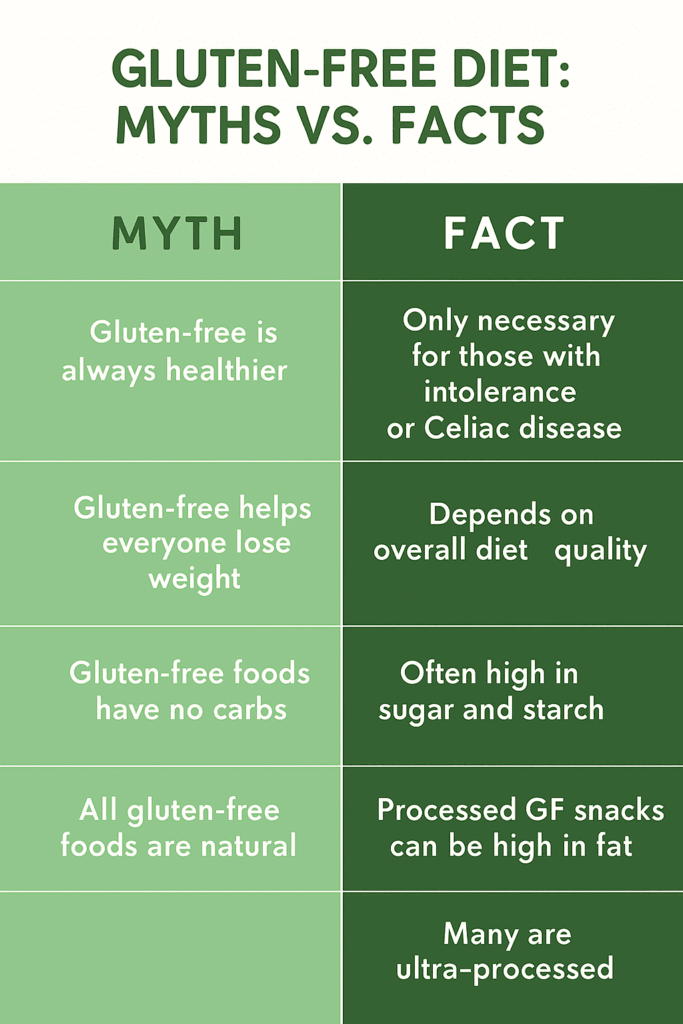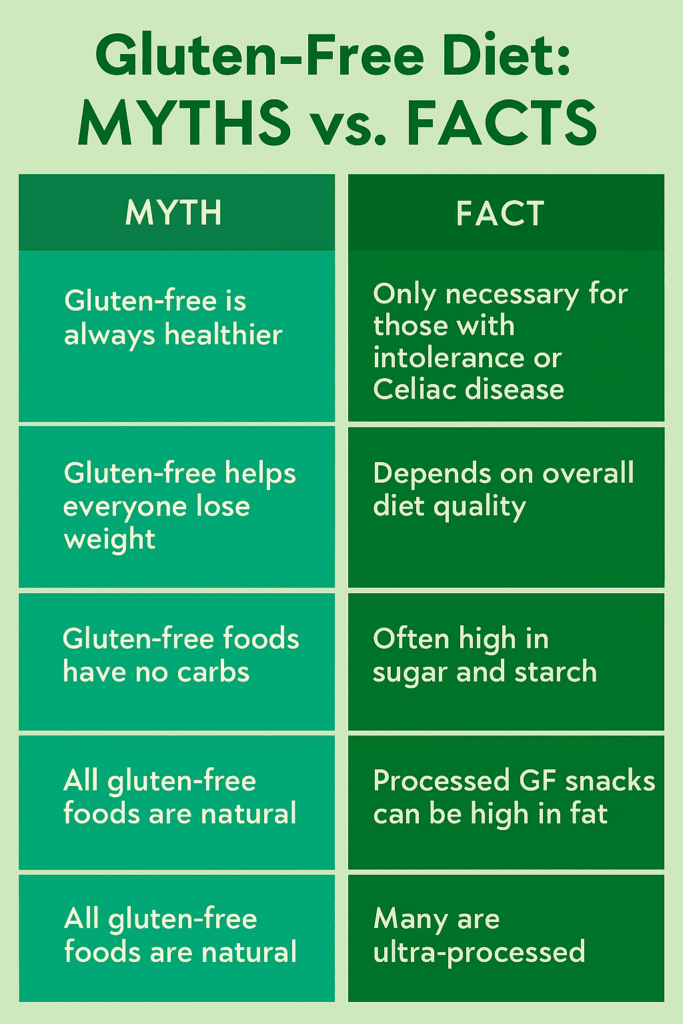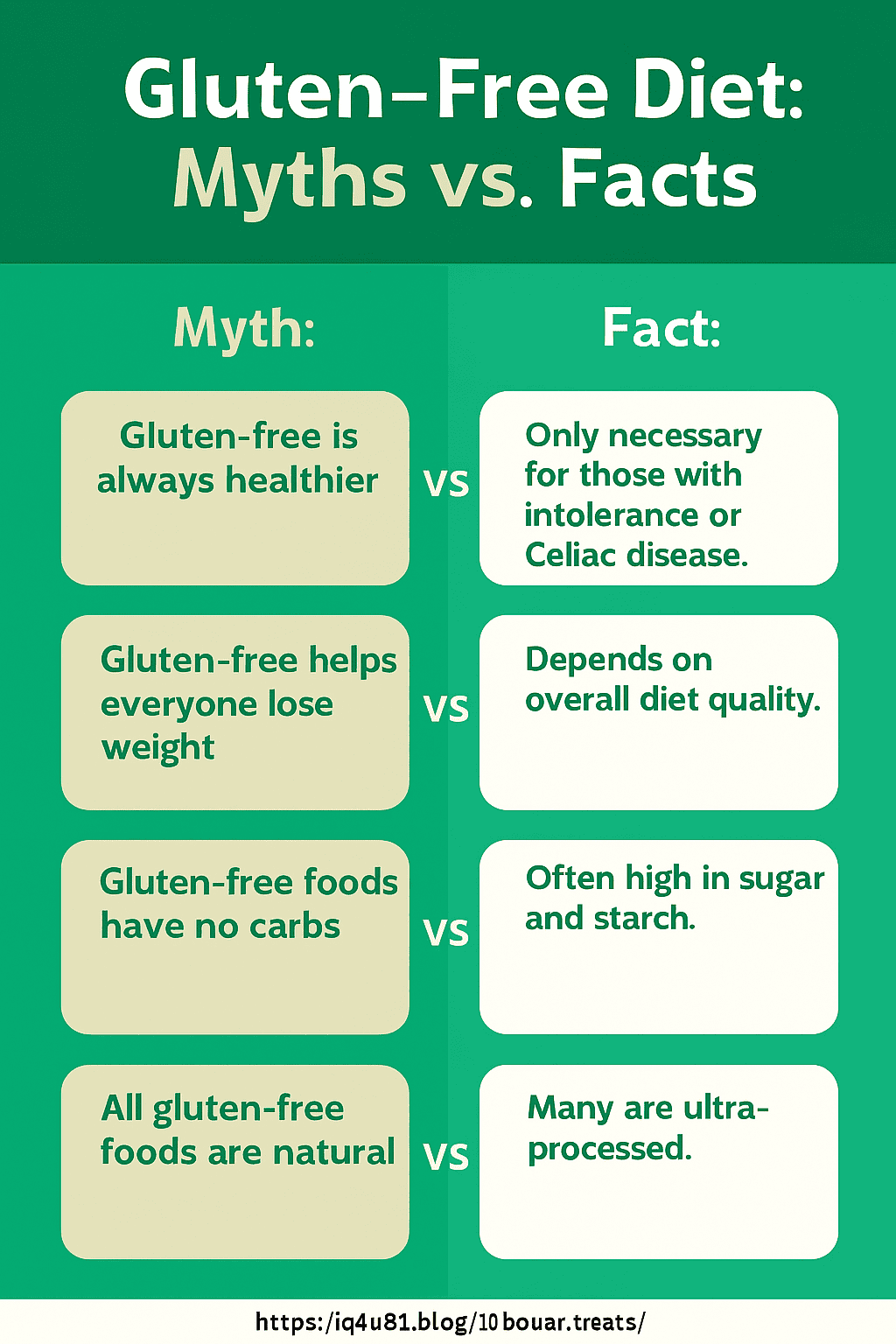Last Updated on October 5, 2025 by Irshad Quadri
1. Introduction
Facts and Myths About Gluten-Free Diet
Have you joined the gluten-free diet bandwagon? Everyone says it is healthier. But is it really so? Today we will uncover the facts and myths about gluten-free diet of this popular trend.
First, understand what is gluten. Gluten is a protein. It is naturally present in grains like wheat, barley, and rye. It is what makes rotis crisp and elastic
But nowadays, going gluten-free has become a fashion statement. Many people think it leads to weight loss. Or it is automatically a healthier option. This is one of the common gluten-free misconceptions
That is why we have brought you a complete guide. We will uncover gluten-free diet myths and truths. We will discuss gluten-free diet pros and cons. Along with that, we will share the truth about gluten-free foods.
This blog will provide you with evidence-based information. We will refer to research studies. So that you can make the best decision for yourself. Is gluten-free diet right for everyone? Or only for some specific people?
We promise you will get 21 interesting facts and myths. Which will be based on pure truth. You will be able to decide for yourself. Will this diet work for your gluten-free health benefits.
For more detailed information, check out our comprehensive guide on 7 Days Gluten-Free Low Cholesterol Diet.
So let’s start this eye-opening journey. Bring your tea or coffee. And get ready to know some surprising truths. Are you ready to bust these myths?
Remember: Understanding the truth behind gluten-free diets empowers you to make better nutritional choices tailored to your specific health needs.
Table of Contents
2. What is a Gluten-Free Diet?
What is a Gluten-Free Diet?
These days, every other health-conscious person says, “I’m on a gluten-free diet!” But first, let’s understand what gluten is. Gluten is a protein found naturally in grains like wheat, barley, and rye. This protein makes dough stretchy and gives bread its fluffy texture.
Now the question arises – why do people avoid gluten? Some people have Celiac disease, in which gluten attacks the immune system. Others are gluten-sensitive and may experience bloating, fatigue, or skin issues. And then there are trend-followers – those who buy gluten-free foods simply by looking at them on Instagram, without any medical reason.
The truth about gluten-free diets is that not everyone needs to avoid gluten. If you don’t have an allergy or medical issue, following a gluten-free diet has simply become a fad. Gluten-free diet misconceptions are quite common – people think it’s automatically healthier, which isn’t always true.
Is a Gluten-Free Diet Healthier? Let’s Clear the Air
You might be thinking, “Eating gluten-free will lead to faster weight loss!” But the truth is that gluten-free foods can also be processed. They can be high in sugar and fat, and low in fiber. So blindly buying based on a gluten-free label isn’t a smart choice.
It’s important to understand the pros and cons of a gluten-free diet. Pros – If you have a problem with gluten, you’ll obviously find relief. Cons – If you avoid it without reason, you could miss out on essential nutrients. Whole grains contain fiber, iron, and B vitamins, which are low in gluten-free alternatives.
Gluten-Free Foods: Trendy but Tricky
Gluten-free bread, pasta, and snacks have flooded the market. But the truth about gluten-free foods is that not all are healthy. The packaging may say “gluten-free,” but it’s important to read the ingredients inside.
You should make smart choices – naturally gluten-free foods like fruits, vegetables, rice, and lentils are best. Don’t buy processed gluten-free items just to follow trends; understand your body’s needs.
Want to try a gluten-free diet? Talk to your doctor first and avoid myths. The key to health is simple – informed choices, not trendy ones!
3. 21 Facts and Myths

A. Myths Busted – Separating Hype from Reality
Truth: Only necessary for people with intolerance.
Truth: Not necessarily, depends on diet quality.
Truth: They often have more sugar and starch.
Truth: Processed gluten-free foods can be high in fat.
Truth: Many are ultra-processed.
B. Facts You Should Know
Fact: Gluten-free diet is essential for Celiac patients.
Fact: Non-Celiac Gluten Sensitivity is real (but rare)
Fact: Gluten-free products are often more expensive
Sometimes fiber, iron, B-vitamins are missing.
Fact: Oats can be gluten-free only if certified
C. Pros of Gluten-Free Diet (When Done Right)
Can help in digestive comfort for intolerant people
Reduces risk of complications in Celiac patients
May encourage healthier whole-food choices (if not relying on packaged food)
Better awareness of food labels & nutrition
D. Cons of Gluten-Free Diet (Risks & Downsides)
Can lead to nutritional deficiencies (iron, fiber, folate)
Often higher in sugar & fat (processed GF Snacks)
Limited food options in social settings
Can be expensive and inconvenient
E. More Myths People Still Believe
Myth: Gluten-free diet boosts athletic performance
Truth: Heart health depends more on fiber, fat, and lifestyle.
Truth: Only necessary if you have a medical reason.
Bonus Section – Going Gluten-Free in Real Life

Going Gluten-Free in Real Life – What It Actually Looks Like
The first word gluten-free diet often makes people think they’ll just have to eat quinoa, almond flour, and imported snacks. But in real life, a gluten-free lifestyle is a little more complex—especially when you’re in a wheat-heavy culture like India. Let’s break it down, step by step, and see what going gluten-free actually means for your plate, your wallet, and your health.
Gluten Is Everywhere in India
First, it’s important to understand that gluten is lurking everywhere in the Indian diet. Roti, paratha, naan, semolina, flour, atta—these are all wheat-based items and loaded with gluten. Even snacks like samosas, kachoris, biscuits, and bakery items are loaded with gluten.
So, if you want to go gluten-free, you first have to replace your daily staples. Millet, jowar, ragi, rice flour, and gram flour—these are all naturally gluten-free alternatives. But switching isn’t always easy. Taste, texture, and availability all have an impact.
Shopping Smart – Read Labels, Avoid Hype
Don’t be fooled by a gluten-free label. Not every product that says “gluten-free” is healthy. Many packaged gluten-free snacks are high in sugar, saturated fat, and preservatives. Imagine—if you’re replacing a regular biscuit with a gluten-free version, but it has double the sugar, what’s the benefit?
So learn to read labels. Check the ingredients list. Pay attention to fiber, protein, and micronutrients. And if you’re confused, be sure to check out trusted guides like 10 Best Gluten-Free Snacks for Lowering Cholesterol.
Budget Impact – Gluten-Free Can Be Pricey
Let’s be honest—gluten-free products aren’t cheap. Imported flours, packaged snacks, and specialty items cost significantly more than regular groceries. If you want to make your entire kitchen gluten-free, your monthly grocery bill can double.
But with smart planning, you can manage costs. Locally available millets like bajra, jowar, and ragi are affordable. Making homemade snacks is also a good option. Plus, you have a natural excuse to avoid processed items.
Nutritional Gaps – Watch Out for Fiber, Iron, and B-Vitamins
One hidden downside of going gluten-free is that you may miss out on some essential nutrients. Wheat-based products naturally contain fiber, iron, and B-vitamins. When you eliminate them, the risk of deficiency increases.
That’s why you need to consciously include nutrient-rich foods in your meals. Lentils, leafy greens, seeds, and fortified products help fill the gap. For fiber-rich options, check out Gluten-Free Fiber Sources That Help Reduce Cholesterol—this guide will be very helpful in your meal planning.
Social Life’s Challenge – Eating Out Isn’t Easy
Indian social culture is food-centric. Weddings, parties, office lunches, roadside chats—gluten is everywhere. If you’re strictly gluten-free, you have to explain every time what you can’t eat. And not every restaurant offers gluten-free options.
Solution? Plan ahead. Identify your go-to safe dishes—like plain rice, dal, vegetables, grilled paneer. And if possible, bring your own snacks. It may seem inconvenient, but it’s worth it for your health.
Mindset Shift – It’s Not About Perfection
A gluten-free lifestyle is a journey, not a one-time switch. Not every meal will be perfect. Accidental gluten exposure can happen occasionally. But if you’re consistent and listen to your body’s signals, you’ll reap long-term benefits.
Digestive comfort, reduced bloating, better energy levels—these are all gradual improvements. And if you’re exploring gluten-free for cholesterol or heart health, 7-Day Indian Meal Plan to Lower Cholesterol (Vegetarian) could be a perfect starting point.
Final Tips for Going Gluten-Free the Smart Way
- Start slow: Replace everything at once. Switch gradually.
- Focus on whole foods: Fruits, vegetables, lentils, millets—these are all naturally gluten-free.
- Avoid processed hype: Packaged gluten-free snacks are not healthy just for the sake of label.
- Track nutrients: Iron, fiber, B-vitamins—monitor your intake of nuts and greens.
- Listen to your body: Every person’s response is different—observe and adapt.
A gluten-free diet can be a powerful tool—if used correctly. Cut through the hype and understand the facts. And if you want to explore, do it with clarity, confidence, and credible guidance.
4. FAQs
FAQs – Gluten Free Recipes to Reduce Triglycerides and LDL
Yes, a gluten-free diet can help when paired with heart-healthy foods like oats, chia seeds, and vegetables.
Oats (certified gluten-free), quinoa, and teff are excellent choices for lowering LDL cholesterol.
Yes, gluten-free meals rich in fiber and protein can support weight loss and improve cholesterol levels.
Yes, recipes rich in soluble fiber such as lentils and beans help lower LDL cholesterol naturally.
Broccoli, spinach, kale, and carrots are excellent vegetables for heart-healthy gluten-free recipes.
Yes, quinoa is gluten-free and provides protein, fiber, and minerals that support healthy triglyceride levels. (NIH Study)
Yes, snacks like roasted chickpeas, nuts, and fruit with yogurt can be both gluten-free and cholesterol-friendly.
Yes, chia seeds are rich in omega-3 fatty acids that help reduce triglycerides. (American Heart Association)
Yes, brown rice is naturally gluten-free and high in fiber, supporting healthy cholesterol levels.
Yes, legumes like beans, peas, and lentils are naturally gluten-free and great for lowering LDL.
Gluten-free breads made from whole grains like quinoa or oats are healthier than refined flour versions.
Yes, flaxseeds are rich in soluble fiber and omega-3s, proven to help reduce LDL. (PubMed Study)
Not always—some gluten-free processed foods can be high in fat and sugar, so choose whole foods instead.
Yes, fruits like apples, oranges, and berries are rich in soluble fiber that lowers LDL.
Yes, nuts like almonds and walnuts are gluten-free and support cholesterol management.
Yes, green tea is naturally gluten-free and its antioxidants help lower LDL cholesterol.
Yes, when combined with low-fat cooking and fiber-rich foods, gluten-free meals boost heart health.
Yes, frying increases unhealthy fats that can raise triglycerides and LDL cholesterol.
It helps reduce risk factors like high LDL and triglycerides, but lifestyle changes are equally important.
With consistent healthy eating, you may notice improvements in 6–12 weeks.
5. Final Verdict – Truth vs Hype
5. Final Verdict – Truth vs. Hype
So far, we've covered quite a bit—myths, facts, pros, and cons—everything has been dissected. The hype surrounding a gluten-free diet is everywhere. From Instagram influencers to supermarket shelves, everyone touts gluten-free. But let's be real—it's not a magic bullet for everyone.
First, let's remember some major myths:
Myth: A gluten-free diet is always healthier.
Truth: It's only necessary for those with an intolerance or celiac disease. For others, it's just a trend.
Myth: Gluten-free foods have no carbs.
Truth: Processed gluten-free snacks are high in sugar and starch. Being carb-free is an illusion.
Myth: A gluten-free diet prevents heart disease.
Truth: The real hero of heart health is fiber, healthy fats, and lifestyle choices—not necessarily gluten-free.
Now, understand some solid facts:
A gluten-free diet is essential for celiac patients—without the complications that can occur.
Non-celiac gluten sensitivity also exists, but is rare.
Gluten-free products often cost more and may lack nutrients like iron, folate, and B vitamins.
And yes, there are some pros—if followed correctly:
Digestive comfort improves for those with intolerances.
Whole-food choices increase when you avoid processed items.
Reading food labels becomes a habit, which is helpful for long-term health.
But the most important thing is this: a gluten-free diet isn't for everyone. Unless you have a medical reason, don't expect miracles. Every body is different, and the impact of every diet is also individual-specific.
Want to explore healthy gluten-free recipes for cholesterol and heart health?
Check out my guides:
👉 10 Best Gluten-Free Snacks for Lowering Cholesterol
👉 Gluten-Free Fiber Sources That Help Reduce Cholesterol
👉 7-Day Indian Meal Plan to Lower Cholesterol (Vegetarian)
Your health journey is unique—so choices should be personalized. Understand the facts, not the hype. And if you want to explore gluten-free, do so smartly—with guidance, not guesswork.
Is Gluten-Free Diet Healthier?
- Only essential for some: A gluten-free diet is medically necessary for people with Celiac disease or gluten intolerance.
- Not a weight-loss guarantee: Removing gluten doesn't automatically lead to weight loss—it depends on overall diet quality.
- Processed GF foods can mislead: Many gluten-free packaged snacks are high in sugar, starch, and saturated fat.
- Risk of nutrient gaps: Gluten-free diets may lack fiber, iron, folate, and B-vitamins found in whole wheat products.
- Whole-food focus helps: When done right, gluten-free eating encourages more fruits, vegetables, and millets.
- Improved digestion for some: People with intolerance often report less bloating and better gut comfort.
- Label awareness increases: Gluten-free eaters tend to read nutrition labels more carefully, improving food literacy.
- Can be expensive: Specialty gluten-free products often cost more than traditional staples.
- Social limitations: Eating out or attending events can be tricky due to limited gluten-free options.
- Not inherently healthier: For the general population, gluten-free is not automatically better—it’s about what replaces it.
My Recommendation
If you are an online learner or you enjoy learning and improving yourself, your lifestyle and your family's too, check out this course — you will thank me for sure!
Explore the CourseAffiliate Disclosure
This blog contains affiliate links, meaning I may earn a small commission if you purchase through these links, at no extra cost to you. I only recommend products I trust and believe will benefit my readers. Your support helps keep this site running—thank you! 🙌

About the Author
Irshad Quadri is a Health & Wellness blogger who simplifies topics like cholesterol management, weight loss, and heart health for everyday readers. On iq4u81.blog, he shares science-backed diet tips, easy recipes, and practical guides to help people live healthier — without losing the joy of food.




